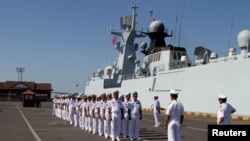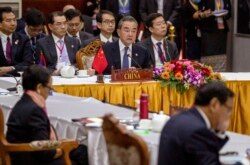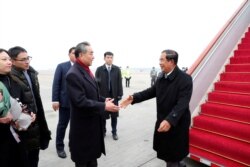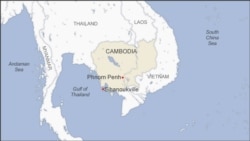China and Cambodia bucked the global trend of event cancellations this week by starting joint military exercises as a way to show the world they’re over the coronavirus outbreak and getting friendlier despite apprehension in other countries.
The two old friends that often chafe against neighboring Vietnam and the United States began their fourth annual joint military drill on Sunday. The activities in Cambodia’s Kampot province will focus on humanitarian rescue work and counterterrorism work before ending April 1, the Chinese official Xinhua News agency reported.
China and its military weaker counterpart are holding their “Dragon Gold 2020” drills amid a global wave of event cancellations to stop the spread of COVID-19, the deadly diseases caused by the coronavirus. China reports more cases than any other country, about 80,000, since the virus was discovered there in December. But new cases have slowed to near none this month.
Officials in Beijing hope to show the world they are reemerging now politically and economically after the outbreak, which is still spreading in Western countries, while Cambodia wants to show solidarity so it can get more Chinese aid, analysts say.
“This is a way of China saying that things are getting back to normal,” said Alan Chong, associate professor at the S. Rajaratnam School of International Studies in Singapore. “I think China wanted to put the COVID-19 virus behind it. There’s every reason to shore up regime legitimacy as soon as possible.”
China had helped Pol Pot’s deadly Khmer Rouge regime in the 1970s as a counterweight to Vietnamese influence in Indochina. Cambodia now gives China a voice in the Association of Southeast Asian Nations (ASEAN), a negotiating bloc where some members have sparred with Beijing over maritime sovereignty issues. Cambodia is one of 10 association members.
China in turn had contributed $2 billion to Cambodian infrastructure as of 2018. The impoverished benefactor has expanded a seaport, opened a road network and made plans for two new airports. Cambodia stands now to get health assistance from China, said Termsak Chalermpalanupap, a fellow with the ISEAS Yusof Ishak Institute in Singapore.
Cambodian Prime Minister Hun Sen traveled to Beijing in February, near the height of the country’s virus outbreak, in what experts call an unusually strong show of moral support.
“Hun Sen last month went all the way to Beijing to meet the Chinese president just to show that Cambodia has big friends who can help Cambodia,” Chalermpalanupap said. The Southeast Asian country hopes to keep getting infrastructure help from China, Chong said.
The exercises’ location in Cambodia happens to be near Ream Naval Base in the host country’s city of Sihanoukville, where China “has a massive presence”, said Thitinan Pongsudhirak, a political science professor at Chulalongkorn University in Bangkok.
Military exercises this month, though not explicitly a war game, are expected to give China stronger presence over time as needed in the southern parts of Indochina, scholars say.
Vietnam will be particularly worried, Chong said. Vietnam borders both and resents Chinese maritime expansion in the South China Sea. Vietnam, also an ASEAN member, and China contest sovereignty over parts of the resource-rich sea.
The China-Cambodia exercises show China’s “commitment” to fracturing ASEAN as in institution, said Stephen Nagy, a senior associate professor of politics and international studies at International Christian University in Tokyo.
“By inculcating itself into Cambodia through joint missions or joint tests or the establishment of a base, this is a very, very effective way to prevent ASEAN from working together as it’s supposed to,” he said.
The Sino-Cambodia drills come after the U.S.-led, multi-country “Cobra Gold” military exercise hosted by Cambodia’s border nation Thailand for 12 days ending March 6. China resents U.S. naval movement in the South China Sea. Washington calls the waterway public, while China claims about 90% of it as its own.











